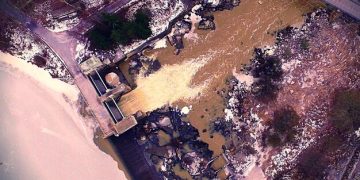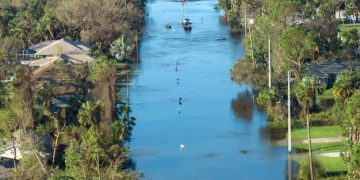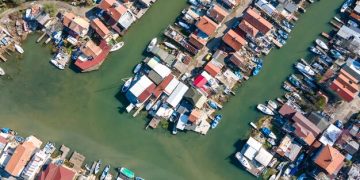US Coastal Economic Losses: Rising Sea Levels by 2030
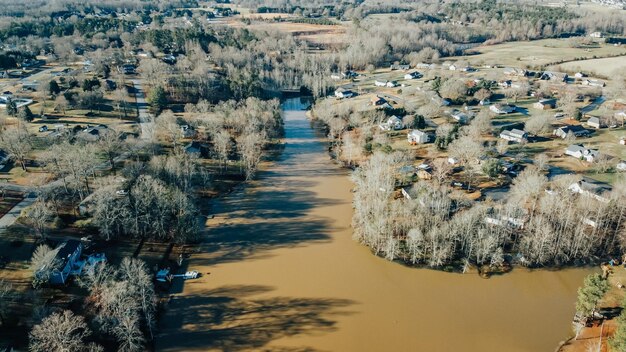
By 2030, US coastal communities face significant projected economic losses due to rising sea levels, encompassing direct property damage, infrastructure degradation, tourism decline, and impacts on unique ecosystems, necessitating urgent adaptation and mitigation strategies to protect vulnerable regions.
Understanding what the projected economic losses in US coastal communities due to rising sea levels by 2030 are is no longer a theoretical exercise but a pressing imperative. As global temperatures continue their relentless ascent, the consequences manifest profoundly across our planet, nowhere more acutely than along the vulnerable coastlines of the United States. This exploration aims to dissect the multifaceted financial toll awaiting these regions, examining the direct and indirect impacts, and the urgent need for strategic foresight.
The Unfolding Reality of Sea Level Rise in the US
The science is unequivocal: sea levels are rising, and the pace is accelerating. This is not just a gradual inundation; it’s a dynamic process driven by thermal expansion of warming oceans and the melting of glaciers and ice sheets. For US coastal communities, this translates into more frequent and severe tidal flooding, exacerbated storm surges, and the slow but relentless erosion of land. The implications extend far beyond environmental concerns, striking at the very heart of economic stability and community resilience.
From the Lowcountry of South Carolina to the bayous of Louisiana, and from the heavily populated coastlines of Florida to the estuarine systems of the Pacific Northwest, each region faces unique challenges but shares a common vulnerability. The short timeframe to 2030 makes the issue particularly acute, as current infrastructure and development patterns are largely unprepared for the changes already set in motion.
A Spectrum of Vulnerabilities: Different Coasts, Different Risks
While the threat of rising sea levels is universal along US coasts, its manifestation varies significantly depending on geological factors, existing infrastructure, and community planning. The Gulf and Atlantic coasts, for instance, are particularly susceptible due to their low-lying topography and subsidence, a natural sinking of the land, which compounds the effects of rising water. Areas like South Florida are built on porous limestone, making adaptation through traditional barriers incredibly complex.
- Southeast and Gulf Coasts: Experience high rates of relative sea level rise due to land subsidence and lower elevations, making them highly vulnerable to inundation and saltwater intrusion.
- Mid-Atlantic Coast: Faces a “hotspot” of accelerated sea level rise, impacting major cities and naval bases.
- West Coast: While generally rockier, certain estuaries and urban centers like San Francisco are threatened, alongside concerns about seismic activity exacerbating flood risks.
The varying rates of rise and local geological conditions mean that a one-size-fits-all approach to economic impact projections is insufficient. Localized assessments are crucial for developing effective and equitable adaptation strategies that recognize the unique characteristics of each coastal community.
Understanding these regional differences is paramount to accurately project economic losses. A flooded street in Miami-Dade County, for instance, affects a different economic ecosystem than saltwater intrusion impacting agricultural lands in coastal Louisiana, though both represent significant financial damage. The interplay of natural processes and human development patterns will dictate the specific pathways of economic disruption in the coming years.
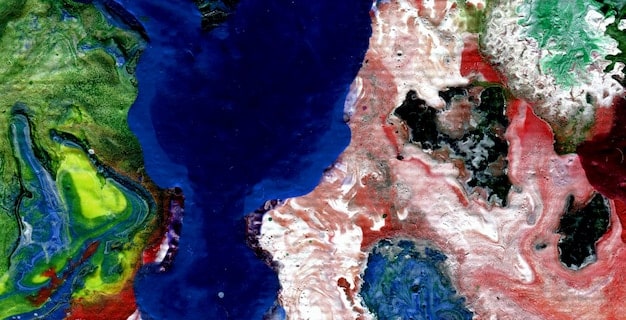
Direct Economic Impacts: Property, Infrastructure, and Agriculture
The most immediate and palpable economic losses stem from direct damage to property and infrastructure. As sea levels rise, residential and commercial properties face increased risks of flooding, leading to diminished property values, higher insurance premiums (or complete loss of insurability), and eventual abandonment. This creates a cascading effect, eroding local tax bases and impacting municipal budgets.
According to various climate economic models, projections indicate that billions of dollars in real estate could be at risk of chronic inundation by 2030. For instance, cities like Miami, New Orleans, and Norfolk are already experiencing “sunny-day flooding,” where high tides alone cause significant disruptions, hinting at the more severe and frequent events to come. The cumulative cost of such events, alongside storm damage exacerbated by higher base sea levels, presents a staggering financial burden.
The Crumbling Coastline: Infrastructure Under Siege
Public infrastructure — roads, bridges, wastewater systems, energy grids, and port facilities — are largely built for historical sea levels. Rising waters and increased salinity accelerate corrosion, undermine foundations, and overwhelm drainage systems. The cost of repairing, elevating, or relocating this critical infrastructure by 2030 will be immense, diverting funds from other essential public services and placing significant strain on local and state budgets.
- Roads and Bridges: Chronic flooding makes transportation networks unreliable, impacting commerce and emergency services.
- Wastewater and Stormwater Systems: Inundation and saltwater intrusion compromise treatment plants and pipes, leading to public health risks and costly upgrades.
- Energy Infrastructure: Power plants, substations, and transmission lines located near the coast are vulnerable to flooding and storm damage, causing widespread outages.
Beyond the direct repair costs, there are also significant indirect losses associated with infrastructure failure, such as lost business productivity due to traffic disruptions or the inability to deliver goods. The interdependency of these systems means that failure in one area can quickly cascade, magnifying the overall economic impact.
Agricultural Losses and Salinity Intrusion
Coastal agriculture, a vital economic sector in many low-lying regions, faces a unique threat from saltwater intrusion into freshwater aquifers and arable land. As sea levels rise, the boundary between fresh and saltwater shifts inland, contaminating irrigation sources and rendering farmland infertile. This leads to diminished crop yields, loss of agricultural livelihoods, and a reduction in the economic output of farming communities.
This impact is particularly acute in states like Louisiana and Florida, where fertile coastal plains support significant agricultural production. The economic losses here are not just about immediate crop failures but also the long-term degradation of agricultural capacity, impacting global food supply chains and increasing dependency on other regions for food resources.
Indirect Economic Impacts: Tourism, Fisheries, and Ecosystem Services
While direct property and infrastructure damage captures immediate attention, the indirect economic impacts of rising sea levels can be equally devastating and often more insidious. Coastal tourism, a multi-billion dollar industry in many US states, relies heavily on pristine beaches, healthy marine ecosystems, and accessible waterfront attractions. As shorelines erode, beaches diminish, and resort areas become more prone to flooding, the appeal – and economic viability – of these destinations will inevitably decline.
The loss of beach amenities alone can lead to reduced visitor numbers, decreased revenue for hotels, restaurants, and local businesses, and job losses. The perception of risk can also deter investment in new coastal development, further stifling economic growth. Iconic coastal communities, from the Outer Banks to Southern California, could see their economic foundations crumble without proactive measures.
Fisheries and Aquaculture Under Threat
Coastal ecosystems, particularly estuaries and wetlands, serve as critical nurseries and habitats for commercial fish species. Rising sea levels alter salinity levels, inundate wetlands, and disrupt delicate ecological balances, directly impacting fish stocks and the livelihoods of fishing communities. Shellfish aquaculture, which often relies on specific salinity conditions, is also highly vulnerable to these shifts.
- Habitat Loss: Submergence of coastal wetlands and estuaries reduces breeding grounds for many fish and shellfish.
- Salinity Changes: Altered freshwater inflow into estuaries impacts species sensitive to specific salt concentrations.
- Increased Storms: More intense storms disrupt fishing operations and damage gear and coastal infrastructure vital for the industry.
The economic losses here extend beyond the immediate catch, affecting processing plants, distributors, and the entire supply chain reliant on healthy fisheries. Communities that have depended on these industries for generations face existential threats, leading to outmigration and cultural decline.
Degradation of Ecosystem Services
Beyond commercial fisheries, healthy coastal ecosystems provide invaluable “ecosystem services” that have significant economic value, though they are often not directly accounted for in traditional markets. Wetlands, for example, act as natural buffers against storm surges, filter pollutants, and store carbon. Mangrove forests stabilize shorelines and provide critical habitats.
As these ecosystems degrade due to rising sea levels, the economic costs associated with their loss become apparent. The expense of building artificial storm barriers to replace wetlands’ protective functions, or the increased public health costs due to diminished natural water filtration, represent hidden economic burdens. By 2030, the cumulative loss of these services could significantly inflate other adaptation costs and decrease overall coastal resilience, adding another layer to the projected economic losses.
Socioeconomic Displacements and Community Resilience
The economic losses projected due to rising sea levels are not merely statistical figures; they translate directly into tangible human impacts: displacement, loss of livelihoods, and the erosion of community identity. Vulnerable populations, often those with fewer resources and limited access to recovery funds, are disproportionately affected. This exacerbates existing social inequalities and can lead to significant demographic shifts in coastal regions.
Relocation becomes an increasingly pressing, and expensive, consideration. The cost of moving entire communities or significant portions of coastal populations involves not only economic outlays for new housing and infrastructure but also profound social and psychological tolls. The disruption to community networks, local economies, and cultural heritage is immeasurable, though its economic consequences manifest in reduced productivity, increased healthcare costs, and overall social instability.
Impact on Local Tax Bases and Government Services
As property values decline and businesses relocate or cease operations in affected coastal areas, the local tax base shrinks dramatically. This directly impacts municipalities’ ability to fund essential services like schools, emergency response, and infrastructure maintenance. Faced with declining revenue and escalating costs for flood protection and recovery, many coastal communities could face severe financial crises, potentially leading to bankruptcy or significant cuts to public services.
The burden of adaptation and resilience also falls heavily on local governments, often requiring massive capital investments for which they are ill-equipped. Without substantial state and federal aid, the financial viability of numerous small to medium-sized coastal towns could be gravely compromised by 2030, contributing to the broader economic losses at a regional and national level.
A Shifting Insurance Landscape
The increasing frequency and severity of coastal flooding and storm events, amplified by rising sea levels, are fundamentally altering the insurance landscape. Insurers are reassessing risks, leading to dramatically higher premiums, reduced coverage availability, or even withdrawal from certain high-risk areas. For property owners, this can make insurance unaffordable or impossible to obtain, leaving them financially exposed to future flood events.
This shift has far-reaching consequences: it directly impacts property values, makes mortgages harder to obtain, and can accelerate the abandonment of vulnerable properties. The economic stability of coastal real estate markets is fundamentally undermined as insurance becomes untenable, pushing more of the flood risk onto public entities or directly onto uninsured homeowners. The financial implications for lenders, homeowners, and even the national economy are immense, highlighting the urgent need for comprehensive risk management strategies.
Mitigation, Adaptation, and Economic Projections for 2030
While the economic losses are projected to be substantial, proactive mitigation and adaptation strategies can help reduce their severity. Mitigation, focused on reducing greenhouse gas emissions, aims to slow the rate of sea level rise in the long term. Adaptation, however, involves preparing for the impacts already underway and those projected for the immediate future, specifically by 2030.
Economic projections for 2030 often include scenarios that factor in varying degrees of adaptation. Investments in resilient infrastructure, such as elevated roads, improved drainage, and natural barriers (like restored wetlands), can protect assets and reduce future damage costs. However, these investments themselves represent significant outlays, illustrating that preventing a loss often requires a substantial upfront expense.
The Cost of Inaction Versus Action
The critical economic question facing coastal communities is the cost of inaction versus the cost of action. Studies consistently show that investing in resilience now is significantly more cost-effective than repeatedly paying for disaster relief and recovery. For every dollar invested in hazard mitigation, an estimated six dollars are saved in future disaster costs.
- Planned Relocation: A drastic but necessary consideration for some highly vulnerable areas, requiring significant economic planning and support for affected communities.
- Nature-Based Solutions: Investing in the restoration of marshes, mangroves, and coral reefs provides crucial natural defenses, often more cost-effective and ecologically beneficial than engineered solutions.
- Policy and Regulatory Reforms: Updating building codes, land-use planning, and zoning laws to reflect future flood risks can prevent new development in high-hazard areas and incentivize resilient construction.
By 2030, only communities that have begun to seriously implement these strategies will likely have mitigated some of the worst economic impacts. Those that continue with business-as-usual approaches face the highest burdens of increased flooding, property abandonment, and infrastructural collapse. The window for effective, proactive adaptation is rapidly closing.
Innovative Solutions and Funding Mechanisms
Addressing the projected economic losses by 2030 requires innovative funding mechanisms and cross-sector collaboration. Public-private partnerships can help finance large-scale resilience projects. Green bonds, climate adaptation funds, and federal grants are emerging as critical tools to channel necessary investments into coastal protection. Furthermore, integrating climate risk into financial planning and investment decisions, both at governmental and corporate levels, is essential.
Technological advancements in flood prediction, early warning systems, and resilient building materials also play a crucial role. The economic impact by 2030 will in part reflect how effectively these innovations are deployed and scaled. The challenge is immense, but the opportunity to build more resilient and economically stable coastal communities remains, provided immediate and strategic action is taken.
Policy Imperatives and the Future of Coastal Economies
Navigating the projected economic losses by 2030 necessitates a robust policy framework at local, state, and federal levels. This includes updating floodplain maps to reflect future sea level rise projections, revising building codes to mandate higher elevation and more flood-resistant construction, and implementing strategic land-use planning that discourages development in the most vulnerable areas. Furthermore, policies that incentivize green infrastructure and nature-based solutions can offer both economic and environmental benefits.
Federal involvement is crucial for providing financial assistance, technical expertise, and a cohesive national strategy for coastal resilience. Without a coordinated effort, the burden on individual communities will be overwhelming. By 2030, states and municipalities need clear guidance and significant investment to make the necessary shifts in planning and infrastructure. The trajectory of economic loss can be altered, but only with decisive and comprehensive policy action.
Rethinking Coastal Development and Economic Growth
The traditional model of coastal development, often involving extensive construction in low-lying areas, must be fundamentally rethought. Future economic growth in coastal regions needs to align with an understanding of increased flood risk and vulnerability. This means exploring economic diversification beyond traditional tourism and real estate in some areas, focusing on industries that are less susceptible to sea level rise, or promoting blue economy sectors that are more adaptive.
Investment should prioritize resilient local economies. This includes supporting small businesses that can quickly adapt to changing conditions and fostering innovation in coastal technologies, such as advanced aquaculture or offshore renewable energy. By 2030, successful coastal economies will likely be those that have embraced these principles, moving away from a purely extractive relationship with the coast to one of stewardship and sustainable adaptation.
The Role of Data and Public Awareness
Accurate, localized data on sea level rise projections and economic vulnerability is paramount for informed decision-making. Public awareness campaigns are also essential to foster community support for often difficult and expensive adaptation measures. When citizens understand the economic stakes and the long-term benefits of resilience investments, they are more likely to support the necessary policies and funding initiatives.
By 2030, the communities that have effectively leveraged data to assess their specific risks and engaged their populations in climate preparedness will be in a much stronger position. The economic future of US coastal communities hinges on a collective commitment to evidence-based policy, proactive adaptation, and a willingness to confront the profound challenges posed by a rapidly changing climate. The projected losses are significant, but so is the potential for strategic resilience.
| Key Area | Brief Description of Economic Impact by 2030 |
|---|---|
| 🏠 Property & Infrastructure | Billions in property value loss, increased damage to roads, bridges, and utilities from chronic flooding and storm surges. |
| ✈️ Tourism & Commerce | Decline in revenue from diminished beaches, disrupted access, and reduced visitor numbers; impacts on local businesses. |
| 🌾 Agriculture & Fisheries | Reduced crop yields due to saltwater intrusion; habitat destruction impacting fish stocks and aquaculture livelihoods. |
| 📈 Insurance & Tax Base | Higher insurance premiums, reduced coverage, and increased financial exposure; shrinking tax bases impacting local government services. |
Frequently Asked Questions About Coastal Economic Losses
Residential homes, commercial buildings, and critical public infrastructure like roads, bridges, and wastewater treatment plants are highly vulnerable. Properties in low-lying coastal zones, especially those built before modern flood resistance standards, face the greatest risk of chronic inundation, leading to decreased value and insurability.
Rising sea levels lead to beach erosion, frequent street flooding, and damage to recreational facilities. This reduces the appeal of coastal destinations, resulting in fewer visitors, lower hotel occupancy, reduced spending at local businesses, and potential job losses in the hospitality sector, affecting the overall economic viability of tourist-dependent areas.
Yes, the Southeast and Gulf Coasts, particularly Florida, Louisiana, and parts of the Mid-Atlantic, are projected to experience some of the most severe economic impacts. This is due to their low elevation, high population density, extensive coastal development, and significant rates of land subsidence compounding the effects of global sea level rise.
As flood risks increase, insurance premiums in coastal areas are soaring, or coverage is becoming unavailable. This places a direct financial burden on property owners and can deter real estate investment. Uninsured losses fall directly onto homeowners and businesses, potentially leading to widespread abandonment and significant hits to local tax revenues.
Absolutely. Proactive investments in adaptation, such as elevating infrastructure, restoring natural coastal barriers, and implementing stricter building codes, can significantly reduce future damage costs. Studies suggest that every dollar spent on mitigation can save multiple dollars in disaster recovery, making early action a critical economic imperative for coastal communities.
Conclusion
The projected economic losses in US coastal communities due to rising sea levels by 2030 are not a distant threat but an imminent reality demanding immediate attention. From direct hits on property and infrastructure to the erosion of vital industries like tourism and fisheries, the financial ramifications are multifaceted and deeply interconnected. Beyond the quantifiable monetary figures, there are profound social costs associated with community displacement and the disruption of long-standing ways of life. However, by embracing robust adaptation strategies, fostering innovative policies, and channeling significant investment into resilient infrastructure and nature-based solutions, coastal communities can mitigate some of the most severe economic damages. The coming years represent a critical window for action, where foresight and collaboration can reshape the economic future of America’s vulnerable coastlines.

